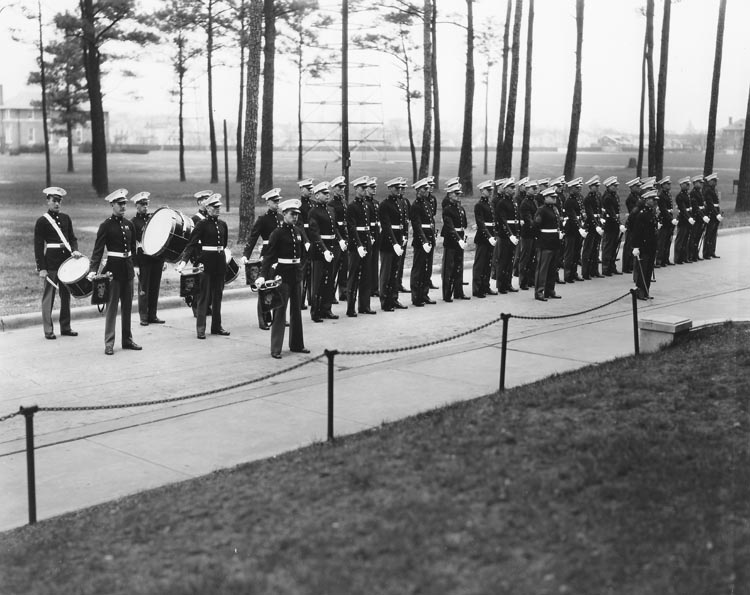Shore
Duty of Leathernecks Provides for Every Minute
Service to the Fleet, October 25, 1941

The parade grounds are empty except for the lonely figures of the guards patrolling back and forth. Only their footsteps and the distant crowing of a rooster show that the world is alive.
Then it's "First Call" and within seconds the quiet is shattered as hundreds of feet strike the floor as Marines tumble out of bed to begin the day. And the day in a Marine barracks begins at 5:55 a.m.
A second call at 6 a.m. is blown by a bugler, whose instrument cries raucously in the dawn, "you can't get 'em up in the morning." It's "reveille."
A life in the day of an average Marine at the barracks in the Navy Yard is described here for the Navy Day section by Lee Baggett, former announcer for NBC radio station who now is stationed here as a public relations man.
The average Marine is five feet ten inches or more tall, is healthy and sturdy. For this story he is called John Jones, hailing from Findlay, Ohio. It's his first enlistment. His day begins with reveille, which is followed by assembly and roll call. For 15 minutes he takes vigorous exercise before returning to his squad room to shave and bathe. Then "chow bombs" blows . . . it's breakfast time. The boys file into the mess hall. They seat themselves at long wooden tables set for 10.
John Jones eats for breakfast this morning a plate of steaming oatmeal with plenty of milk, then stows away generous helpings of ham and eggs. He tops it off with an orange. Then he joins the line of men taking their dishes to steel racks for stacking until dish washing is done.
At 7:20 a.m. it is cleaning-up time, or "police call." Washing the deck, stowing clothes neatly in lockers and making everything shipshape are morning chores. Twenty-four minutes is allowed for this.
The sun is well up by now, and a bugle call sounds again. It is "colors." The flag is run up the mast while the entire barracks personnell stands at attention. Private Jones, in fresh, clean uniform, with shining face, falls out with the rest of the men chosen for guard duty. It's 8:10 a.m. and "guard mount," the colorful changing of the guard ceremony is conducted to the music of the Marine Band.
Private Jones is on call for 24 hours while on guard duty. He stands guard for four hours, is off for eight. Over 300 men in the Navy Yard are not on guard duty at all times, but are attached to Sea School where thry are trained in the duties they must perform when sent to sea.
Private Bland, a friend of Jones, attends this school. He spends each day cramming his mind with details about the nomenclature and construction of ships. He may have gunnery duty, orderly duty, or be stationed with a gun crew. He may be studying to qualify as one of 100 enlisted men who attend the Naval Academy each year. The Sea School is operated like a miniature Naval Academy.
Inspection of quarters and troop inspection begins each day at school and at 9:15 a.m. the first class settles down to work. Lectures and demonstrations are conducted by instructors, sergeants who have served for years with the corps. They lecture on everything that pertains to ships.
Gunnery drills find the Marines practicing loading deck guns that can be used as either anti-aircraft weapons or for delivering broadsides against surface craft.
The dinner bugle sounds at 11:55 a.m. and at 1 p.m. the afternoon's routine begins. It follows the lines of the morning program. But at 4 o'clock the bugler sounds two calls. Those due to have an early supper leave for the mess hall. The second call is the "Liberty call." Five minutes before sunset the call to "colors" sounds.
The Marines' day ends at 9:45 o'clock, when those remaining in their barracks settle down to 15 minutes of quiet chatting and smoking before "taps" is heard.